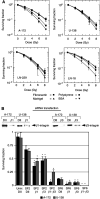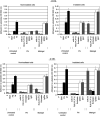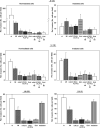Irradiation differentially affects substratum-dependent survival, adhesion, and invasion of glioblastoma cell lines
- PMID: 14647148
- PMCID: PMC2376852
- DOI: 10.1038/sj.bjc.6601429
Irradiation differentially affects substratum-dependent survival, adhesion, and invasion of glioblastoma cell lines
Abstract
Effects of ionising radiation on extracellular matrix (ECM)-modulated cell survival and on adhesion and invasion are not well understood. In particular, the aggressiveness of glioblastoma multiforme has been associated with tumour cell invasion into adjacent normal brain tissue. To examine these effects in more depth, four human glioblastoma cell lines (A-172, U-138, LN-229 and LN-18) were irradiated on fibronectin (FN), Matrigel, BSA or polystyrene. Major findings of this study include a significantly increased survival of irradiated A-172 but not of irradiated U-138, LN-229, and LN-18 cells on FN or Matrigel compared to cells irradiated on polystyrene or BSA. Irradiation induced a dose-dependent increase in functional beta 1- and beta 3-integrins in all four glioma cell lines. This integrin induction caused improved cell adhesion to FN or Matrigel. In contrast to U-138, LN-229 and LN-18 cells, irradiation strongly impaired A-172 cell invasion. Invasion of all cell lines was inhibited by anti-integrin antibodies, the disintegrin echistatin and the MMP-2/-9 inhibitor III. Additionally, beta 1- and beta 3-integrins modulated basal and radiation-altered gelatinolytic activity of MMP-2. Tested glioblastoma cell lines showed a differential cellular susceptibility to FN or Matrigel which affected the cellular radiosensitivity. Three out of four glioma cell lines demonstrated a combination of a substratum-independent survival after irradiation and an invasive potential which was not affected by irradiation. beta 1- and beta 3-integrins were identified to play a substantial, regulatory role in survival, adhesion, invasion and MMP-2 activity. Detailed insights into radioresistance and invasion processes might offer new therapeutic strategies to enhance cell killing of lethal high-grade astrocytoma.
Figures







Similar articles
-
Fibronectin and laminin increase resistance to ionizing radiation and the cytotoxic drug Ukrain in human tumour and normal cells in vitro.Int J Radiat Biol. 2003 Sep;79(9):709-20. doi: 10.1080/09553000310001610240. Int J Radiat Biol. 2003. PMID: 14703944
-
Cell adhesion to the extracellular matrix protein fibronectin modulates radiation-dependent G2 phase arrest involving integrin-linked kinase (ILK) and glycogen synthase kinase-3beta (GSK-3beta) in vitro.Br J Cancer. 2003 May 6;88(9):1470-9. doi: 10.1038/sj.bjc.6600912. Br J Cancer. 2003. PMID: 12778079 Free PMC article.
-
Cell adhesion-mediated radioresistance (CAM-RR). Extracellular matrix-dependent improvement of cell survival in human tumor and normal cells in vitro.Strahlenther Onkol. 2003 May;179(5):337-44. doi: 10.1007/s00066-003-1074-4. Strahlenther Onkol. 2003. PMID: 12740661
-
Glioma cell invasion: regulation of metalloproteinase activity by TGF-beta.J Neurooncol. 2001 Jun;53(2):177-85. doi: 10.1023/a:1012209518843. J Neurooncol. 2001. PMID: 11716069 Review.
-
Molecular targets of glioma invasion.Cell Mol Life Sci. 2007 Feb;64(4):458-78. doi: 10.1007/s00018-007-6342-5. Cell Mol Life Sci. 2007. PMID: 17260089 Free PMC article. Review.
Cited by
-
Effects of radiation on the metastatic process.Mol Med. 2018 Apr 24;24(1):16. doi: 10.1186/s10020-018-0015-8. Mol Med. 2018. PMID: 30134800 Free PMC article. Review.
-
Differential Superiority of Heavy Charged-Particle Irradiation to X-Rays: Studies on Biological Effectiveness and Side Effect Mechanisms in Multicellular Tumor and Normal Tissue Models.Front Oncol. 2016 Feb 25;6:30. doi: 10.3389/fonc.2016.00030. eCollection 2016. Front Oncol. 2016. PMID: 26942125 Free PMC article. Review.
-
Integrin signalling and the cellular response to ionizing radiation.J Mol Histol. 2004 Mar;35(3):327-37. doi: 10.1023/b:hijo.0000032364.43566.3a. J Mol Histol. 2004. PMID: 15339052 Review.
-
Effects of irradiation on tumor cell survival, invasion and angiogenesis.J Neurooncol. 2010 Dec;100(3):323-38. doi: 10.1007/s11060-010-0199-4. Epub 2010 May 7. J Neurooncol. 2010. PMID: 20449629 Review.
-
Effects of connective tissue growth factor (CTGF) gene silencing on the radiosensitivity of glioblastoma.Int J Clin Exp Med. 2014 Sep 15;7(9):2557-63. eCollection 2014. Int J Clin Exp Med. 2014. PMID: 25356109 Free PMC article.
References
-
- Adams JC, Watt FM (1990) Changes in keratinocyte adhesion during terminal differentiation: reduction in fibronectin binding precedes alpha 5 beta 1 integrin loss from the cell surface. Cell 63: 425–435 - PubMed
-
- Albelda SM (1993) The role of integrins and other cell adhesion molecules in tumor progression and metastasis. Lab Invest 68: 4–17 - PubMed
-
- Ballin M, Gomez DE, Sinha CC, Thorgeirsson UP (1988) Ras oncogene mediated induction of a 92-kDa metalloproteinase: strong correlation with the malignant phenotype. Biochem Biophys Res Comm 154: 832–838 - PubMed
-
- Bauman GS, Fisher BJ, McDonald W, Amberger VR, Moore E, Del Maestro RF (1999) Effects of radiation on a three-dimensional model of malignant glioma invasion. Int J Dev Neurosci 17: 643–651 - PubMed
MeSH terms
Substances
LinkOut - more resources
Full Text Sources
Miscellaneous

